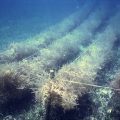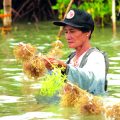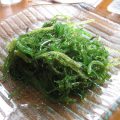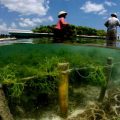According to statistics, people who live in Japan are healthier and actually live longer than the people in the United States.
Seaweed is a staple food of the island country of Japan. This is the key factor in their health and their longevity. Seaweed contains higher contents of fiber than vegetables, more protein than meat, and more calcium than milk. Seaweed is actually a good ingredient to put into everyone’s diet.
Dr. Marco Nemesio E. Montaño from the Marine Science Institute, College of Science, University of the Philippines Diliman, Quezon City, discussed in a seminar during the 2008 Agriculture and Fisheries Technology Commercialization Forum of the Bureau of Agricultural Research (BAR) the health benefits of seaweeds. He underscored the multitude effects of dietary algae, which include having antioxidant, antiviral, antiinflammatory, antibacterial, antitumor and antiwrinkle properties, aside from the fact that it lowers blood pressure, lowers glucose, lowers cholesterol, and inhibit cell-cell adhesion.
Dr. Montaño also said that there are some pytochemicals unique to seaweeds. These include the seaweed pigments or carotenoids like fucoxanthin, seaweed sterols, phlorotannins, fibers, seaweed anti-herbivore chemical defenses, and acidic polysaccharides (fucoidan, carrageeanan).
Fucoxanthin is a pharmacologically active carotenoid commonly distributed in brown algae. It acts as an antioxidant and inhibits GOTO cells of neuroblastoma and colon cancer cells. It has also been found that fucoxanthin reduces the viability of prostate cancer cells by inducing apoptosis to a greater extent than the other carotenoids. Additionally, it can also induce apoptosis in human leukemia cells.
In terms of wellness, a new product line developed from seaweed extracts is the Seamoy (with approved patent and trademark). This is a seaweed based, low-cost air freshener gel. It makes use of sweet floral scents to give every room, car, lockers and cabinets a clean, fresh smell. The gel could be easily handled and could be packed in a variety of ways.
The use of seaweeds as a base ingredient for air fresheners has improved the quality of those existing in the market today. Air freshener gels, specifically, usually last only for two to three weeks whereas some soft gels, which may contain soft paraffin, even cause clogging in air-conditioning units. Moreover, air freshener gels are costly due to the high production cost of its base ingredient, carrageenan. Carrageenan is an algal polysaccharide used to give the air freshener gel a clear appearance. It is extracted from certain types of seaweeds using chemicals and equipment which result in increased production cost. Dr. Montaño addressed concerns on the shelf-life, environmental effect, and market cost of air-freshener gels.
The seaweed-based air freshener gel uses dried Eucheuma sp. seaweeds as base. Eucheuma is a red seaweed cultivated in the southern part of the Philippines and is one of the top five exports of the country. This type of seaweed contains carrageenan and cellulosic materials. However, instead of extracting the carrageenan, the whole seaweed is used, thus, reducing the cost of production. The gel produced using the whole dried seaweed is not translucent in form. However, the gel strength remains the same as that of the carrageenan-based gel. Dr. Montaño used hard paraffin and diatomaceous earth (decalite) to control the release of the essence in the gel resulting in a prolonged shelf-life. Furthermore, hard paraffin does not evaporate in room temperature therefore preventing the clogging of air-conditioning units. Also, the residue of the seaweed-based air freshener gel is biodegradable, thus making the product environment-friendly.
Another product from seaweeds, as mentioned by Dr. Montaño, is the red sushi sheet. The said product is derived from Halymenia durvillaei. Unlike other sushi sheets, this exhibits a bright red color which enhances the appearance of the sushi sheet. Product development is still on-going to improve its appearance, texture, flavor, and over-all quality.
Likewise, development of farming technologies for H. durvillei is still in-progress, thus, exact costing cannot be made yet. Approximately, in making the sushi sheet, a pack (6×6 inches, 10pcs) would cost Php 11.00.
Other seaweed products would include Euginthol, Fruit Cubes, Low Calorie Jelly, Egg Coatings, Decorating Gel, Instant Gum Paste, Low Calorie Mapple Syrup, Low Cholesterol Flan, Algro Fertilizers, Halimuyak Gel Soap, Dishwashing Soap, Halimuyak Liquid Soap, Ginhaua Ointment, Suppository Base, and R-PE. R-PE is a fluorescent red pigment extracted from red seaweeds used in flow cytometry and as coloring for food and cosmetics. It has antioxidant property. What is being studied is whether or not R-PE has antibacterial and anticancer properties.
In conclusion, Dr. Montaño said that seaweeds are important and significant renewable resource of the country. He encouraged the participants during the seminar, especially those interested to venture into seaweed business, to initiate research and development activities that would facilitate funding and improve the seaweed industry. In relation, participation of the government, private sector and the academe in the development of this so-called “ocean herb” is essential.
by Christmas B. de Guzman
by HMERNANDEZ & MNMONTAÑO






